Design of MIMO Antenna with an Enhanced Isolation Technique
Abstract
1. Introduction
- Different DGS structures are proposed to obtain mutual coupling reduction between two circular patches. These structures, which are closely placed to each other on top of the substrate, operate at a frequency of 5.3 GHz which is better than 4.8 GHz [26].
- In this work, circular patches are used instead of rectangular patches because circular resonators provide better performance in terms of S-parameters, voltage standing wave ratio (VSWR), and other parameters [27].
- A novel approach is implemented on different DGS shapes (the ground is cut off in I-shaped, T-shaped, and H-shaped) to get less return loss (S11) and insertion loss (S21) which results in −32 dB and −41 dB, respectively. The reduction in the insertion loss is better than previous work (e.g., [12,28]). A compact MIMO antenna is presented with high isolation between the MIMO radiating elements (S21/S12 < −41 dB).
- The proposed H-shape MIMO antenna has a better gain performance compared to previous work (e.g., [29,30]). Additionally, the envelope correlation coefficient (ECC) and diversity gain are utilized to evaluate antennas for the first time to check the performance along with efficiency, directivity, and gain.
- The feeding scheme for the two patches is coaxial probes extended from the bottom ground layer. This scheme is easily implemented due to less spurious radiation effects as compared with [31]. Meanwhile, to obtain impedance matching this method can be placed at any desired position inside the patch.
2. Proposed Model Design and Analysis
2.1. Antenna Design
2.2. Evolution Process
3. Simulation Results
3.1. S-Parameters
3.2. Voltage Standing Wave Ratio
3.3. Antenna Gain
3.4. Directivity
3.5. Radiation Pattern
3.6. Surface Current Distribution
4. Proposed MIMO Antenna Performance
4.1. Diversity Analysis
4.1.1. Envelope Correlation Coefficient
4.1.2. Diversity Gain
4.2. Total Active Reflective Coefficient
4.3. Efficiency
5. Comparison of Proposed Work with Related Works
6. Conclusions
Author Contributions
Funding
Conflicts of Interest
References
- Andrews, J.G.; Buzzi, S.; Choi, W.; Hanly, S.V.; Lozano, A.; Soong, A.C.; Zhang, J.C. What will 5G be? IEEE J. Sel. Areas Commun. 2014, 32, 1065–1082. [Google Scholar] [CrossRef]
- Foschini, G.J.; Gans, M.J. On limits of wireless communications in a fading environment when using multiple antennas. Wirel. Pers. Commun. 1998, 6, 311–335. [Google Scholar] [CrossRef]
- Yang, F.; Rahmat-Samii, Y. Microstrip antennas integrated with electromagnetic band-gap (EBG) structures: A low mutual coupling design for array applications. IEEE Trans. Antennas Propag. 2003, 51, 2936–2946. [Google Scholar] [CrossRef]
- Ramachandran, A.; Pushpakaran, S.V.; Pezholil, M.; Kesavath, V. A four-port MIMO antenna using concentric square-ring patches loaded with CSRR for high isolation. IEEE Antennas Wirel. Propag. Lett. 2015, 15, 1196–1199. [Google Scholar] [CrossRef]
- Arora, A.; Kumar, N. To reduce mutual coupling in microstrip patch antenna arrays elements using electromagnetic band gap structures for X-band. In Proceedings of the 2017 International Conference on Nextgen Electronic Technologies: Silicon to Software (ICNETS2), Tamilnadu, India, 23–25 March 2017; pp. 228–230. [Google Scholar]
- Kawakami, Y.; Kuse, R.; Hori, T.; Fujimoto, M. Decoupling of dipole antenna array on patch type metasurface with parasitic cells. In Proceedings of the 2017 11th European Conference on Antennas and Propagation (EUCAP), Paris, France, 19–24 March 2017; pp. 2603–2606. [Google Scholar]
- Yu, Y.; Yi, L.; Liu, X.; Gu, Z.; Li, J. Mutual coupling reduction of dual-frequency patch antennas using a simple microstrip H-Section. In Proceedings of the 2015 IEEE International Symposium on Antennas and Propagation & USNC/URSI National Radio Science Meeting, Vancouver, BC, Canada, 19–25 January 2015; pp. 388–389. [Google Scholar]
- Zhao, L.; Piao, D. Mutual Coupling Reduction of Microstrip MIMO Antenna Array by Differential Feeding. In Proceedings of the 2018 Cross Strait Quad-Regional Radio Science and Wireless Technology Conference (CSQRWC), Xuzhou, China, 21–24 July 2018; pp. 1–3. [Google Scholar]
- Wu, C.-H.; Chiu, C.-L.; Ma, T.-G. Very compact fully lumped decoupling network for a coupled two-element array. IEEE Antennas Wirel. Propag. Lett. 2015, 15, 158–161. [Google Scholar] [CrossRef]
- Ban, Y.-L.; Chen, Z.-X.; Chen, Z.; Kang, K.; Li, J.L.-W. Decoupled hepta-band antenna array for WWAN/LTE smartphone applications. IEEE Antennas Wirel. Propag. Lett. 2014, 13, 999–1002. [Google Scholar]
- Wang, H.; Liu, L.; Zhang, Z.; Li, Y.; Feng, Z. Ultra-compact three-port MIMO antenna with high isolation and directional radiation patterns. IEEE Antennas Wirel. Propag. Lett. 2014, 13, 1545–1548. [Google Scholar] [CrossRef]
- Zhang, S.; Pedersen, G.F. Mutual coupling reduction for UWB MIMO antennas with a wideband neutralization line. IEEE Antennas Wirel. Propag. Lett. 2015, 15, 166–169. [Google Scholar] [CrossRef]
- Chiu, C.-Y.; Cheng, C.-H.; Murch, R.D.; Rowell, C.R. Reduction of mutual coupling between closely-packed antenna elements. IEEE Trans. Antennas Propag. 2007, 55, 1732–1738. [Google Scholar] [CrossRef]
- Lee, C.-T.; Wong, K.-L. Internal WWAN clamshell mobile phone antenna using a current trap for reduced ground plane effects. IEEE Trans. Antennas Propag. 2009, 57, 3303–3308. [Google Scholar]
- Dadgarpour, A.; Zarghooni, B.; Virdee, B.S.; Denidni, T.A.; Kishk, A.A. Mutual coupling reduction in dielectric resonator antennas using metasurface shield for 60-GHz MIMO systems. IEEE Antennas Wirel. Propag. Lett. 2016, 16, 477–480. [Google Scholar] [CrossRef]
- Karimian, R.; Kesavan, A.; Nedil, M.; Denidni, T.A. Low-mutual-coupling 60-GHz MIMO antenna system with frequency selective surface wall. IEEE Antennas Wirel. Propag. Lett. 2016, 16, 373–376. [Google Scholar] [CrossRef]
- Gao, P.; He, S.; Wei, X.; Xu, Z.; Wang, N.; Zheng, Y. Compact printed UWB diversity slot antenna with 5.5-GHz band-notched characteristics. IEEE Antennas Wirel. Propag. Lett. 2014, 13, 376–379. [Google Scholar] [CrossRef]
- Capobianco, A.; Khan, M.; Caruso, M.; Bevilacqua, A. 3–18 GHz compact planar antenna for short-range radar imaging. Electron. Lett. 2014, 50, 1016–1018. [Google Scholar] [CrossRef]
- Ghosh, T.; Ghosal, S.; Mitra, D.; Bhadra Chaudhuri, S.R. Mutual coupling reduction between closely placed microstrip patch antenna using meander line resonator. Prog. Electromagn. Res. 2016, 59, 115–122. [Google Scholar] [CrossRef]
- Zhang, S.; Lau, B.K.; Sunesson, A.; He, S. Closely-packed UWB MIMO/diversity antenna with different patterns and polarizations for USB dongle applications. IEEE Trans. Antennas Propag. 2012, 60, 4372–4380. [Google Scholar] [CrossRef]
- Suntives, A.; Abhari, R. Miniaturization and isolation improvement of a multiple-patch antenna system using electromagnetic bandgap structures. Microw. Opt. Technol. Lett. 2013, 55, 1609–1612. [Google Scholar] [CrossRef]
- Zhu, F.-G.; Xu, J.-D.; Xu, Q. Reduction of mutual coupling between closely-packed antenna elements using defected ground structure. Electron. Lett. 2009, 45, 601–602. [Google Scholar] [CrossRef]
- Adamiuk, G.; Beer, S.; Wiesbeck, W.; Zwick, T. Dual-orthogonal polarized antenna for UWB-IR technology. IEEE Antennas Wirel. Propag. Lett. 2009, 8, 981–984. [Google Scholar] [CrossRef]
- Wang, L.; Wang, G.; Zhao, Q. Suppressing mutual coupling of MIMO antennas with parasitic fragment-type elements. In Proceedings of the 2016 46th European Microwave Conference (EuMC), London, UK, 4–6 October 2016; pp. 1303–1306. [Google Scholar]
- Kumar, A.; Devane, S. DGS based mutual coupling reduction between microstrip patch antenna arrays for WIMAX applications. In Proceedings of the 2016 2nd International Conference on Next Generation Computing Technologies (NGCT), Dehradun, India, 14–16 October 2016; pp. 78–83. [Google Scholar]
- Hammoodi, A.I.; Raad, H.; Milanova, M. Mutual Coupling Reduction between Two Circular Patches Using H-Shape DGS. In Proceedings of the 2018 IEEE International Symposium on Antennas and Propagation & USNC/URSI National Radio Science Meeting, Boston, MA, USA, 8–13 July 2018; pp. 1371–1372. [Google Scholar]
- Satapathy, S.; Mohanta, H.C. Contrastive Parametric Analysis of Rectangular and Circular Microstrip Patch Antenna. Int. J. Res. Innovation Appl. Sci. 2017, 2, 19–22. [Google Scholar]
- Blanch, S.; Romeu, J.; Corbella, I. Exact representation of antenna system diversity performance from input parameter description. Electron. Lett. 2003, 39, 705–707. [Google Scholar] [CrossRef]
- Mak, A.C.; Rowell, C.R.; Murch, R.D. Isolation enhancement between two closely packed antennas. IEEE Trans. Antennas Propag. 2008, 56, 3411–3419. [Google Scholar] [CrossRef]
- Cao, Y.; Cheung, S.W.; Yuk, T.I. Frequency-reconfigurable multiple-input–multiple-output monopole antenna with wide-continuous tuning range. IET Microw. Antennas Propag. 2016, 10, 1322–1331. [Google Scholar] [CrossRef]
- Bisht, S.; Saini, S.; Prakash, V.; Nautiyal, B. Study the various feeding techniques of microstrip antenna using design and simulation using CST microwave studio. Int. J. Emerg. Technol. Adv. Eng. 2014, 4, 318–324. [Google Scholar]
- Sharawi, M.S. Printed MIMO Antenna Engineering; Artech House: Norwood, MA, USA, 2014. [Google Scholar]
- Hussain, R.; Khan, M.U.; Sharawi, M.S. An integrated dual MIMO antenna system with dual-function GND-plane frequency-agile antenna. IEEE Antennas Wirel. Propag. Lett. 2017, 17, 142–145. [Google Scholar] [CrossRef]
- Qu, L.; Zhang, R.; Kim, H. Decoupling between ground radiation antennas with ground-coupled loop-type isolator for WLAN applications. IET Microw. Antennas Propag. 2016, 10, 546–552. [Google Scholar] [CrossRef]
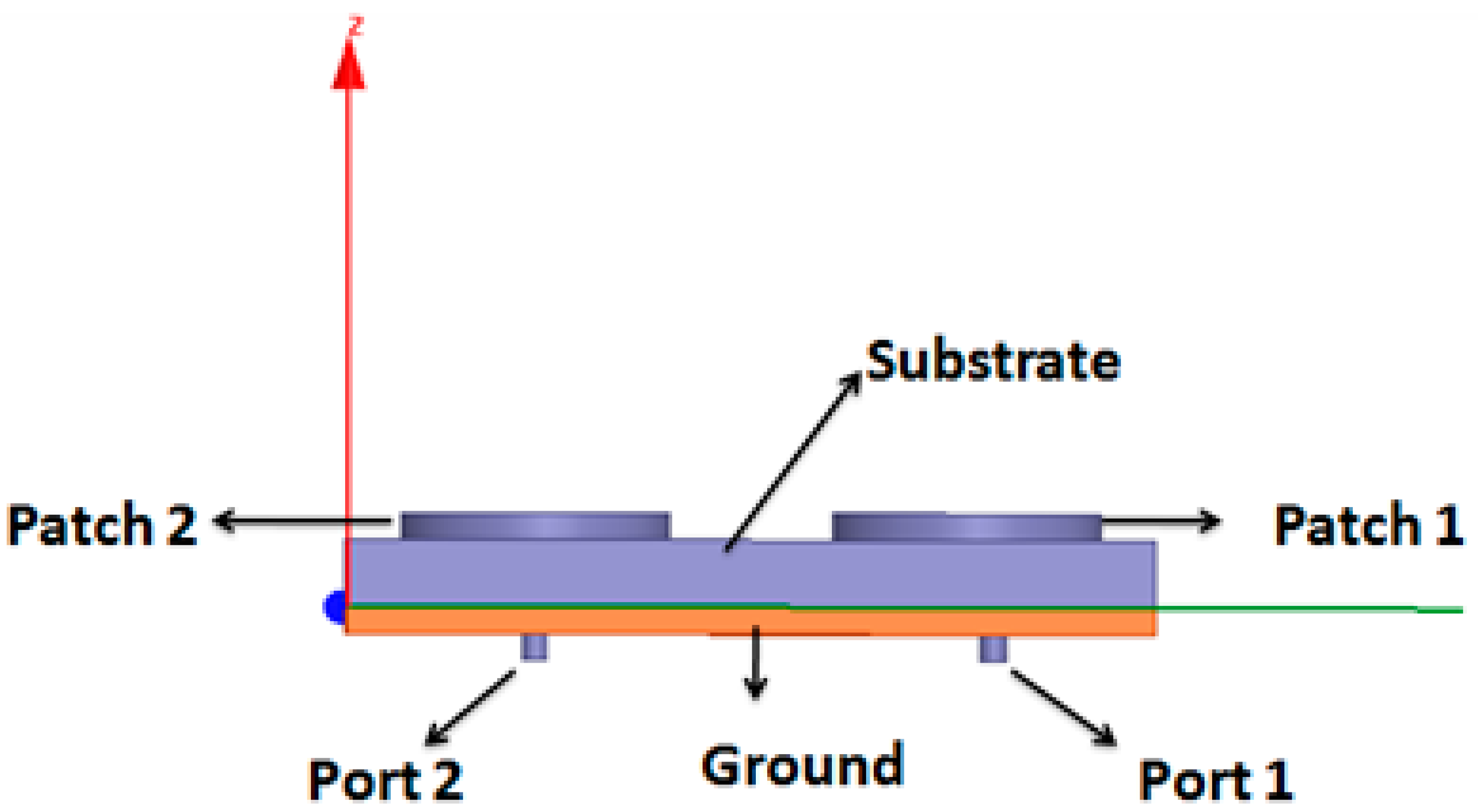
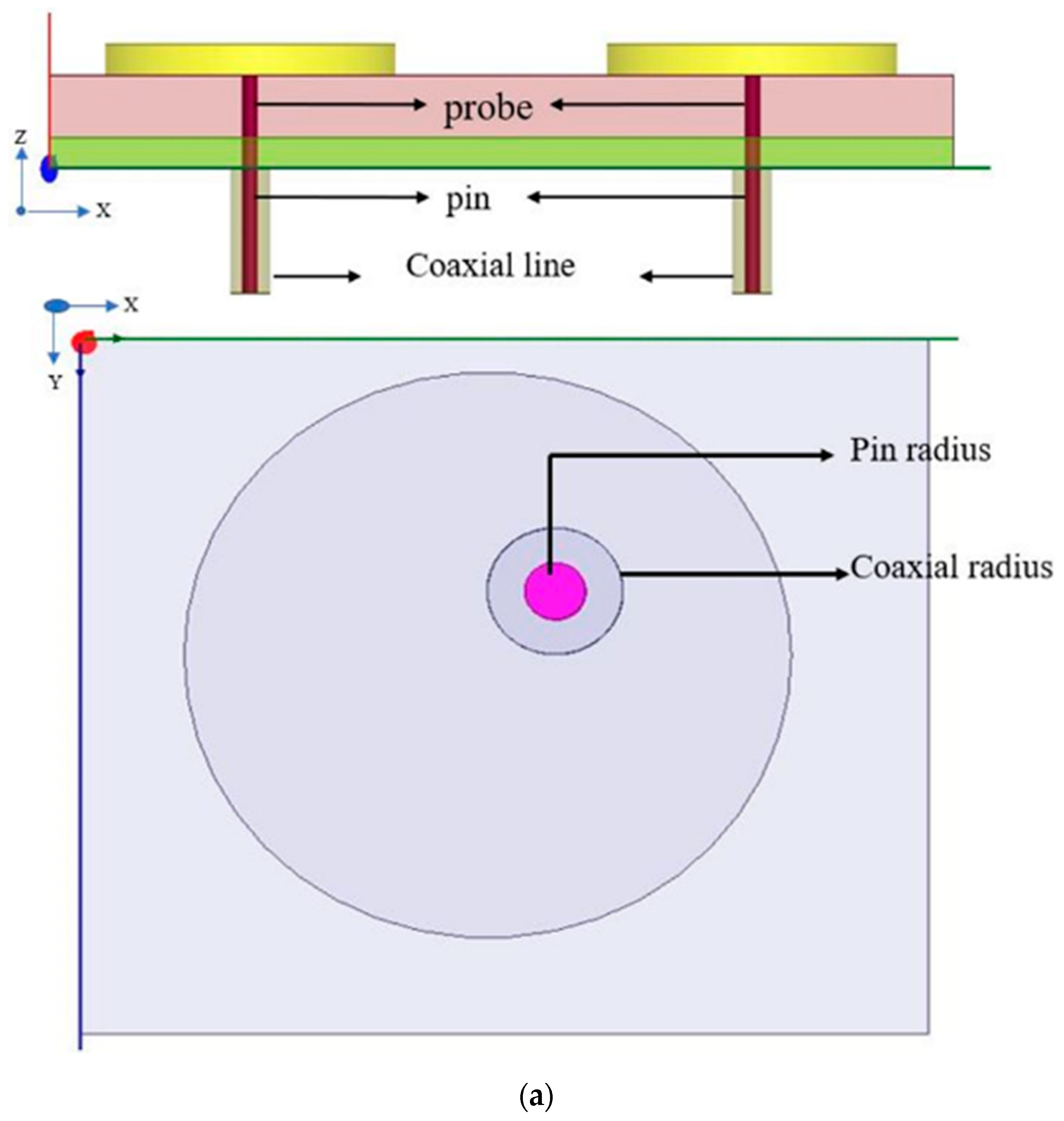
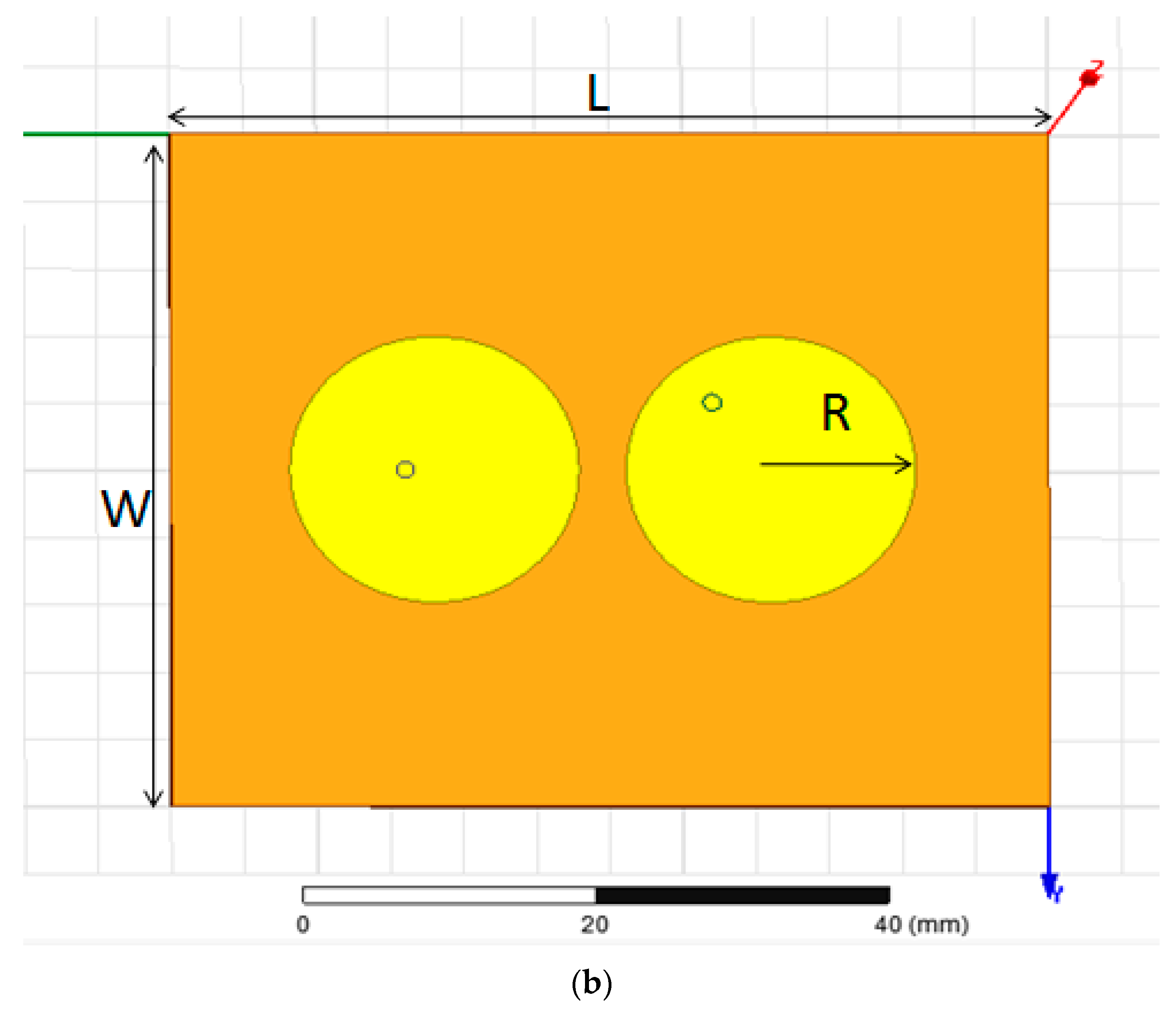



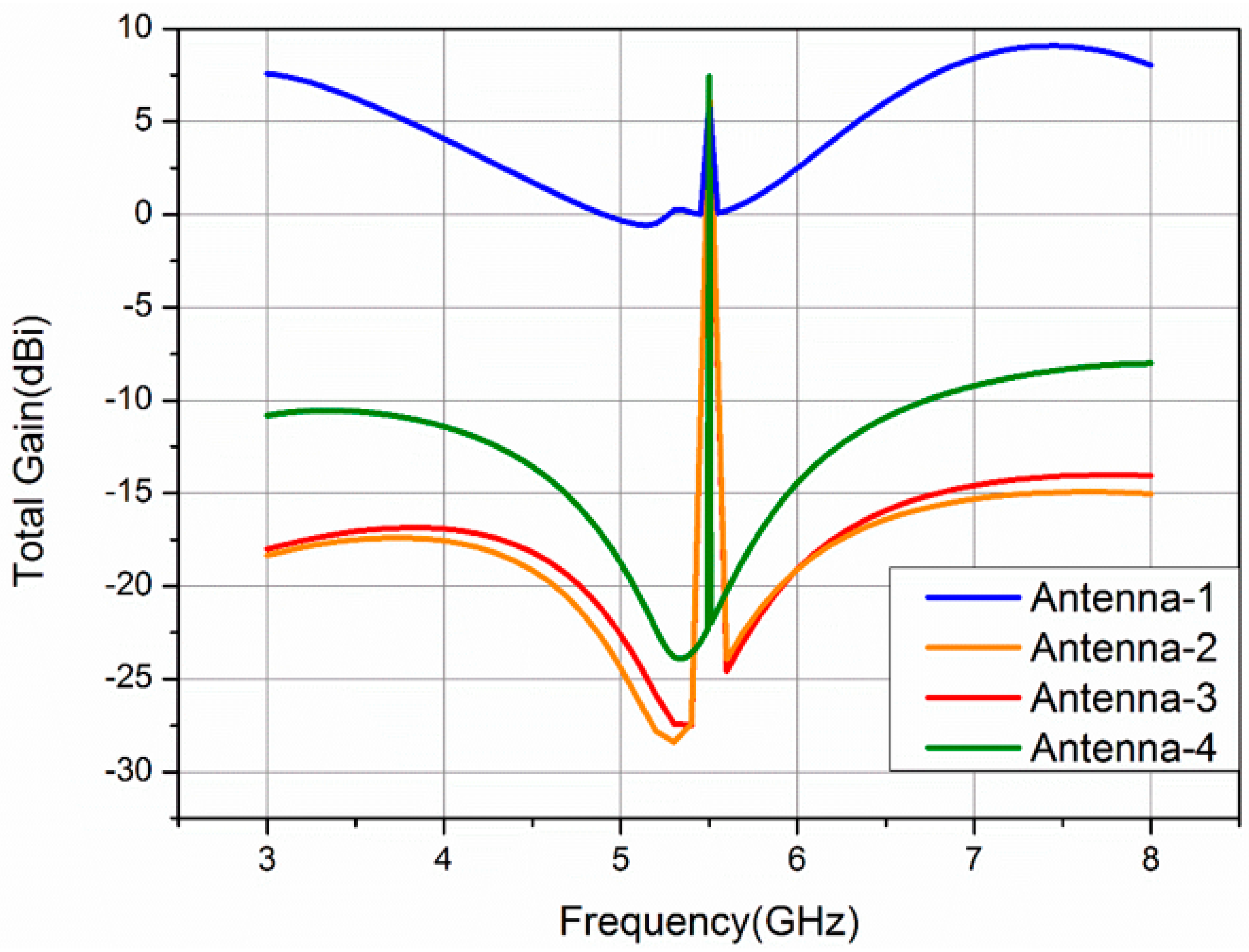




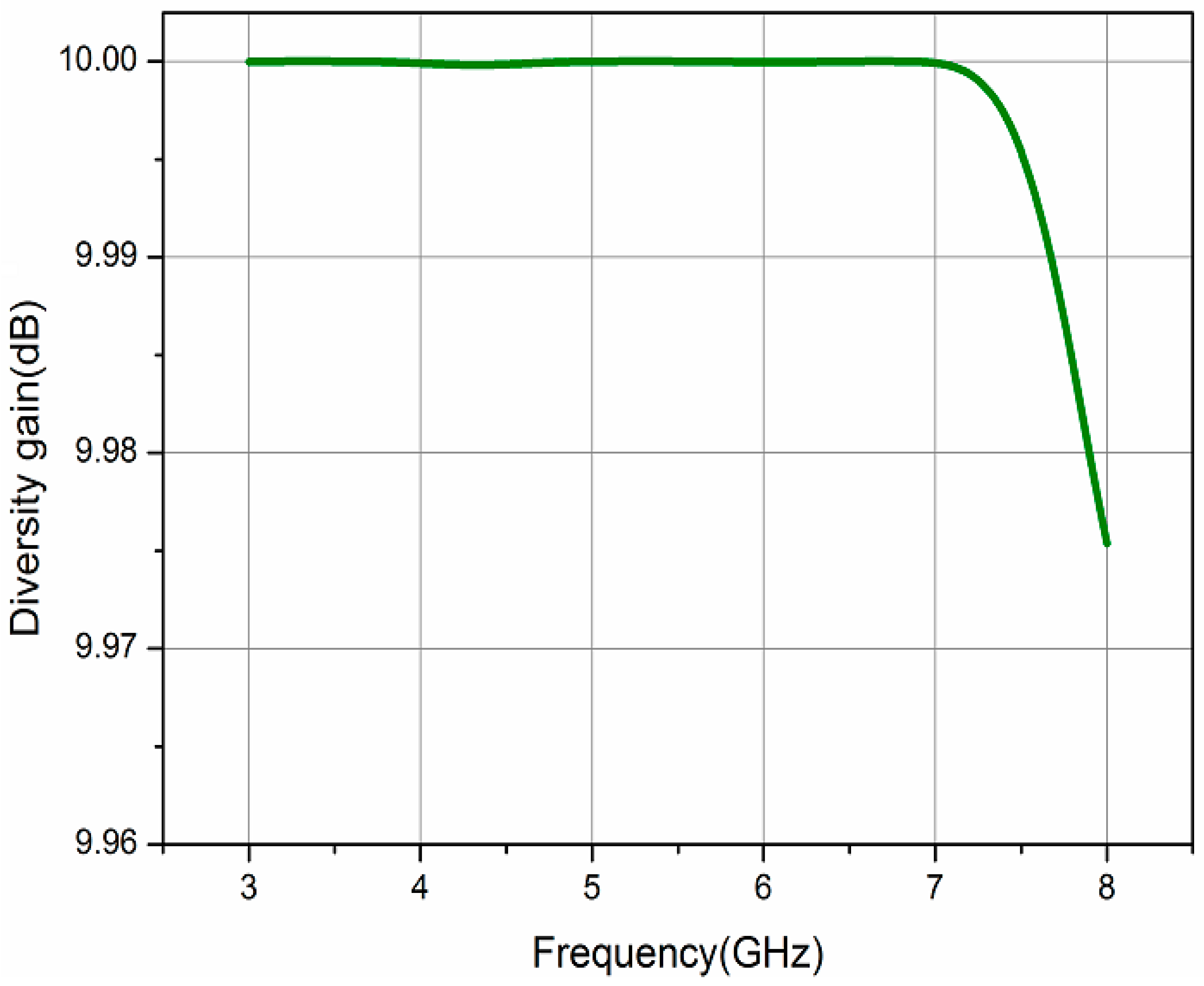
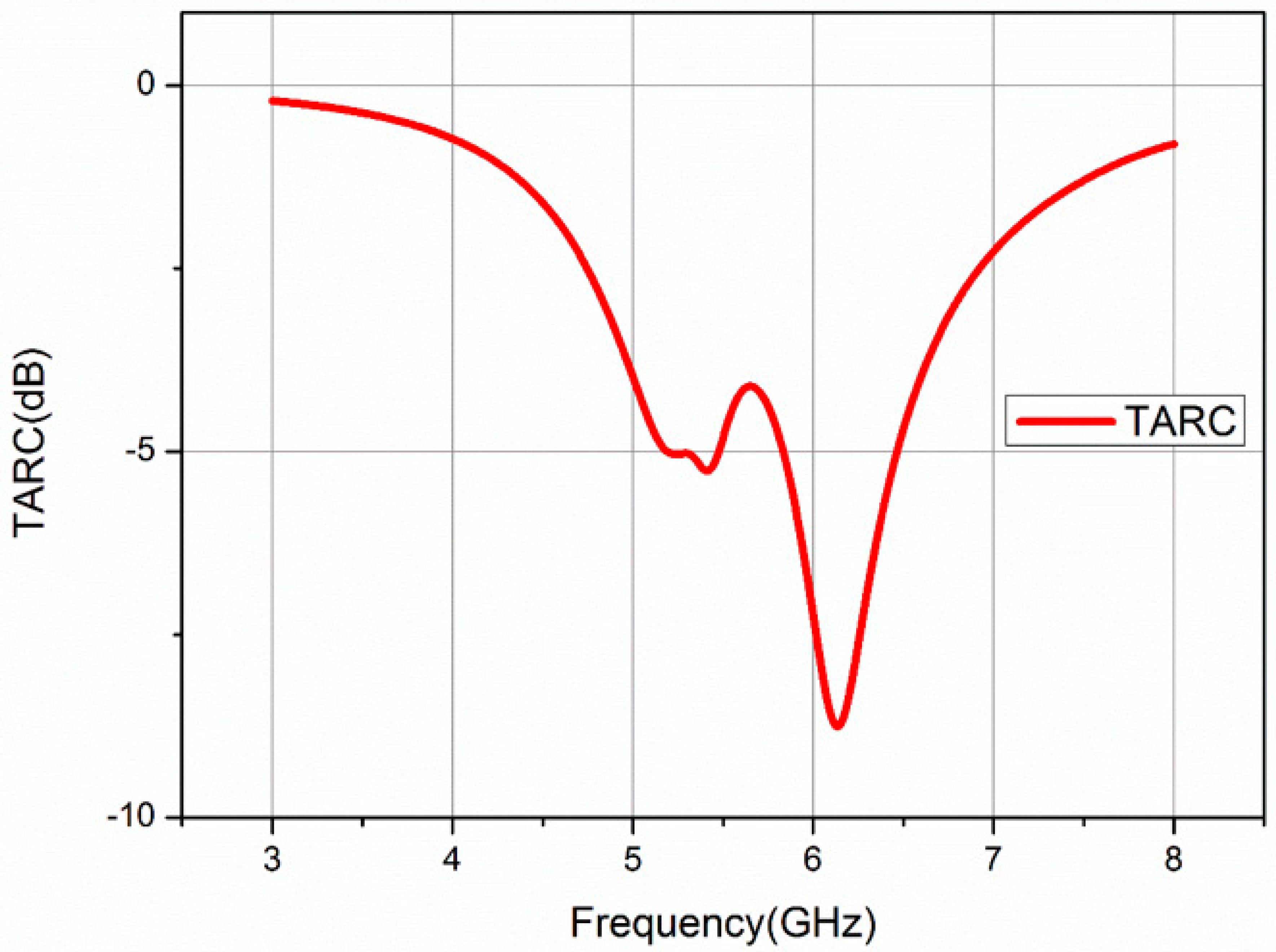

| Parameters | Value (mm) | Parameters | Value (mm) |
|---|---|---|---|
| Substrate length (L) | 60 | Patch-2 radius (R2) | 9 |
| Substrate width (W) | 50 | Pin-2 radius | 0.6 |
| Height (H) | 1.46 | Pin-2 height | 3 |
| ) | 3 | Probe-2 radius | 0.6 |
| Patch-1 radius (R1) | 9 | Probe-2 height | 1.46 |
| Ground length | 60 | Coaxial-2 radius | 1 |
| Ground width | 50 | Coaxial-2 height | 3 |
| Pin-1 radius | 0.6 | Ground cutoff-1 length (Ls) | 23 |
| Pin-1 height | 3 | Ground cutoff-2 length (Ws) | 16.5 |
| Probe-1 radius | 0.6 | Ground cutoff-3 length (Ws) | 16.5 |
| Probe-1 height | 1.46 | Ground cutoff width | 0.2 |
| Coaxial-1 radius | 1 | Port-1 radius | 1 |
| Coaxial-1 height | 3 | Port-2 radius | 1 |
| Ground cut off-1 radius | 1 | Ground cut off-2 radius | 1 |
| Ref. | Isolation Technique | S21 (dB) | Gain (dB) | ECC | Efficiency (%) |
|---|---|---|---|---|---|
| [4] | CSRR | −22 | 3.4 | 0.4 | 84.6 |
| [6] | Parasitic cells | −13 | NA | NA | NA |
| [8] | Differential feeding | −17 | 8 | NA | NA |
| [12] | Neutralization Line | −22 | 5 | 0.1 | NA |
| [25] | DGS 1-antenna | −17 | NA | NA | NA |
| [26] | DGS2-antennas | −18 | 5.5 | NA | NA |
| [29] | Rectangular slot | −30 | 2 | NA | 65 |
| [30] | U-shape slot | −20 | 1.6 | 0.5 | NA |
| [33] | Annular slot | −22 | 2.3 | 0.015 | 83 |
| [34] | Loop type | −14 | 2.05 | 0.3 | 62.5 |
| Proposed | DGS 4-antennas | −41 | 8.40 | 0.0072 | 98.01 |
© 2020 by the authors. Licensee MDPI, Basel, Switzerland. This article is an open access article distributed under the terms and conditions of the Creative Commons Attribution (CC BY) license (http://creativecommons.org/licenses/by/4.0/).
Share and Cite
Khan, A.; Geng, S.; Zhao, X.; Shah, Z.; Jan, M.U.; Abdelbaky, M.A. Design of MIMO Antenna with an Enhanced Isolation Technique. Electronics 2020, 9, 1217. https://doi.org/10.3390/electronics9081217
Khan A, Geng S, Zhao X, Shah Z, Jan MU, Abdelbaky MA. Design of MIMO Antenna with an Enhanced Isolation Technique. Electronics. 2020; 9(8):1217. https://doi.org/10.3390/electronics9081217
Chicago/Turabian StyleKhan, Asif, Suiyan Geng, Xiongwen Zhao, Zahoor Shah, Mishkat Ullah Jan, and Mohamed Abdelkarim Abdelbaky. 2020. "Design of MIMO Antenna with an Enhanced Isolation Technique" Electronics 9, no. 8: 1217. https://doi.org/10.3390/electronics9081217
APA StyleKhan, A., Geng, S., Zhao, X., Shah, Z., Jan, M. U., & Abdelbaky, M. A. (2020). Design of MIMO Antenna with an Enhanced Isolation Technique. Electronics, 9(8), 1217. https://doi.org/10.3390/electronics9081217






